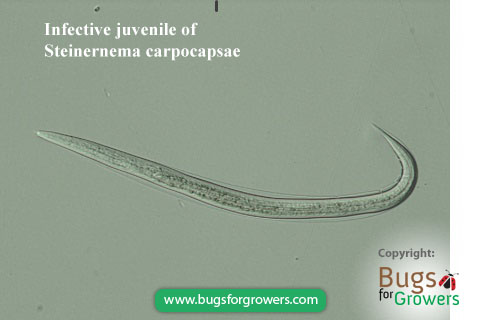Beneficial Steinernema carpocapsae nematodes have a potential to control tropical sod webworm, Herpetogramma phaeopteralis, one of the most damaging pests of turfgrass. Sod worms are lepidopterous insects that cause a serious damage to turfgrasses that are grown in the athletic fields, golf courses, home lawns and recreational parks. Adult moths do not cause any type of damage to turfgrass but their larval stages feed on turfgrass and reduce its aesthetic value. Sod webworms develop through four different developmental stages including egg, caterpillar/larva, pupa and adult moth. Adult moths are light, brown or dull ash gray in color with snout-like mouthparts. The full grown larvae/caterpillars of sod webworms are gray, brown or greenish in color, about 1 inch long with four parallel rows of distinct dark spots along the length of their body and coarse hair distributed all over the body. Sod webworms overwinter as caterpillar in silk-lined tunnels prepared in thatch and/or soil. In the spring, overwintering caterpillars resume feeding on new turfgrass growth, while feeding molts (shed its cuticle) 5-9 times and go through 6-10 stages (instars) of development. Last instar larva pupates inside the cocoons built from soil particles and plant debris in May through June. After 10-15 days of pupation, adult moths emerge from pupae and begin mating. After mating, female moths generally start laying their eggs individually while they are flying and dropping them randomly into the grass. Each moth lays up to 500 eggs in 10 to 15 days. Under optimal environmental temperatures, eggs hatch within 7-15 days. Immediately after hatching from eggs, small larvae starts feeding on grass foliage. These second generation caterpillars of sod webworms feed through September then overwinter and life cycle continues.
Sod webworm larvae also called caterpillars feed at crown level by chewing leaves and stems of turfgrass. This type of feeding causes thinning of grass in small areas and as the infestation progresses, these damaged small areas turn into large brown irregular patches. These large sized and irregular patches of dry grass are easily noticed because they are randomly distributed throughout the lawns or golf course. Sod webworm caterpillars feed at night but hide in the silk-lined tunnels prepared by them in thatch and/or soil during day time. The presence of irregular brown patches of dead grass caused by sod webworm feeding in the middle of a lawn or golf course can reduce its aesthetic value.
Biological control of sod webworms with Steinernema carpocapsae nematodes
As chemical pesticides may be detrimental to human health and the environment, beneficial entomopathogenic nematodes (Fig. 1) can serve as a safe alternative to pesticides to control sod webworms. All the larval and pupal stages of sod webworms have shown susceptibility to beneficial entomopathogenic nematodes including Steinernema carpocapse (Grewal et al., 2005; Tofangsazi et al., 2014). Beneficial Steinernema carpocapsae nematodes are commercially available and they can be applied at the rate of 1 billion nematodes per acre of a lawn or golf course for the effective control of sod webworms. These nematodes are easily applied using water cans on a small areas or using traditional sprayers on a large area (more than 5000 square foot). The beneficial nematodes cannot survive if they are exposed to ultraviolet light and therefore, the best time to apply these nematodes in any field situation including lawns and golf courses is evening. Also, the irrigation after nematode application is always helpful for washing them off of grass blades into thatch/ soil and for the movement of nematodes throughout soil profile to seek their insect hosts including sod webworms, Herpetogramma phaeopteralis.
When applied infective juveniles of Steinernema carpocapse can find sod webworm larvae or pupae and infect them by entering into their body cavity via natural openings such as mouth, anus and spiracles. Once infective juveniles of Steinernema carpocapse nematodes are in the insect body cavity, they release several cells of symbiotic bacteria called Xenorhabdus nematophila from their gut via anus in the sod webworm blood, which is conducive for the multiplication of symbiotic bacteria. In the blood, multiplying nematode-bacterium complex causes septicemia and kill sod webworm caterpillars usually within 48 h after infection. If enough host insects are available, these nematodes have an ability to recycle themselves after their first application.
Research papers
Grewal, P.S. Koppenhofer, A.M. and Choo, H.Y. 2005. Lawn, turfgrass and pasture applications. In: Nematodes As Biocontrol Agents. Grewal, P.S. Ehlers, R.-U., Shapiro-Ilan, D. (eds.). CAB publishing, CAB International, Oxon. Pp 115-146.
Fight insect pests with eco-friendly beneficial organisms: www.bugsforgrowers.com
